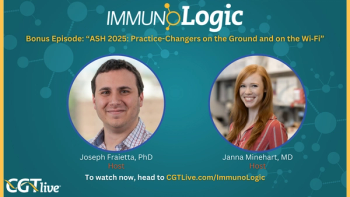
ICER Throws Support Behind Clinical, Cost Value of Hemophilia Gene Therapies in Draft Report
A substantial benefit noted for EtranaDez and val-rox is that they are delivered as a single-dose.
The Institute for Clinical and Economic Review (ICER) has released a draft report comparing clinical benefit and cost effectiveness of CSL’s etranacogene dezaparvovec (EtranaDez), an investigational gene therapy intended for the treatment of hemophilia B, and BioMarin’s valoctocogene roxaparvovec (val-rox; BMN-270), a gene therapy for the treatment of hemophilia A, to current standards of care.1
The report compared EtranaDez with factor IX prophylaxis, pointing out an initial positive success rate for EtranaDez for patients who receive a full dose and do not have high antibody titers to the adenovirus vector. It was additionally noted that bleeding rates of all types were lower in years 4 and 5 of long-term follow-up for the initial cohort of treated patients (n=5).
“It is not yet clear that the initial increase in factor IX levels will be maintained for decades, though the results are encouraging...,” the report concludes.1 “Because of the uncontrolled study design, small numbers of patients studied and relatively short follow-up, there is still considerable uncertainty about the long-term net benefits of EtranaDez compared with factor IX prophylaxis. In particular, there are uncertainties about the long-term impact of the therapy on liver function and the risk for hepatocellular carcinoma. However, the short-term results clearly favor EtranaDez and the harms seem relatively modest."
Val-rox was compared with factor VIII prophylaxis. It was noted that patients in the GENEr8-1 trial (NCT03370913) experienced a relative risk reduction of 84% for treated joint bleeds and 85% for treated bleeds compared with baseline annualized bleeding rates (ABR) during the 6-month run-in phase on factor VIII prophylaxis. However, the report highlighted that efficacy of val-rox for individual patients varies, with some patients getting a significant benefit while others receive minimal benefit or no benefit. No direct comparison between val-rox and emicizumab prophylaxis, which is in the process of replacing factor VIII prophylaxis as a standard of care, could be made due to the lack of head to head data.
“Indirect evidence suggests that the short-term reduction in bleeding rates compared with factor prophylaxis with valoctocogeneroxaparvovec is at least as great as that observed with emicizumab compared with factor prophylaxis,” the report states.1 “However, differences in the patient populations studied in the trials could be responsible for the observed benefits. Furthermore, there are clear initial adverse events with valoctocogene roxaparvovec (high risk of elevated liver enzymes requiring prolonged corticosteroid therapy)… Finally, as factor levels have been observed to decline over time, the benefits of valoctocogene roxaparvovec could be relatively short-lived. The lack of direct data comparing [val-rox and Emicizumab], the small number of treated patients, and the modest long-term follow-up leave considerable uncertainty about the net health benefits.”
A substantial benefit noted for both gene therapies is that they are delivered as a single-dose, reducing the burden for patients who currently require dosing with current standards of care monthly or multiple times weekly. It was also concluded that both gene therapies are associated with large cost savings compared with standards of care. However, in a model of a capped cost savings scenario, val-rox was not determined to be cost effective, while EtranaDez was.
EtranaDez’s biologics license application (BLA) was
Val-rox has been approved in the European Union and is expected to begin commercial sales before the end of 2022, but it remains an investigational therapy in the United States.2 The approval in the EU was supported by results from GENEr8-1, which were published earlier this year in the New England Journal of Medicine,2 demonstrating a statistically significant increase in mean factor VIII activity level at weeks 49 through 52 (41.9 IU per deciliter; 95% CI, 34.1-49.7; P <.001) as well as a 98.6% and 83.8% decrease in rates of factor VIII concentrate use and treated bleeding after week 4, respectively (P <.001). All participants experienced at least 1 adverse event (AE), with 16.4% experiencing a serious AE. Elevations in alanine aminotransferase levels occurred in 85.8% of participants, with other common AEs including headache, nausea, and elevations in aspartate aminotransferase levels. BioMarin intends to re-submit a BLA to the FDA for val-rox before the end of September 2022. A BLA was previously
"BioMarin is pleased that ICER recognizes the potentially transformative impact of Roctavian as possibly the first gene therapy treatment for severe hemophilia A, and potential to not only deliver profound patient benefit, but also potential long-term healthcare savings," Jeff Ajer, executive vice president, chief commercial officer, BioMarin, said in a statement regarding the new ICER draft report.3
REFERENCES
1. Gene therapy for hemophilia B and an update on gene therapy for hemophilia A: effectiveness and value. Draft Evidence Report. The Institute for Clinical and Economic Review. September 13, 2022. https://icer.org/wp-content/uploads/2022/05/ICER_Hemophilia-Draft-Evidence-Report_09132022_Updated.pdf
2. Ozelo MC, Mahlangu J, Pasi KJ, et al; GENEr8-1 Trial Group. Valoctocogene roxaparvovec gene therapy for hemophilia A. N Engl J Med. 2022;386(11):1013-1025. doi:10.1056/NEJMoa2113708
3. BioMarin's gene therapy for adults with severe hemophilia A, ROCTAVIAN™ (valoctocogeneroxaparvovec), assessed to provide substantial cost savings per patient in a preliminary independent report. News release. BioMarin Pharmaceutical Inc. September 15, 2022. https://investors.biomarin.com/2022-09-15-BioMarins-Gene-Therapy-for-Adults-with-Severe-Hemophilia-A,-ROCTAVIAN-TM-valoctocogene-roxaparvovec-,-Assessed-to-Provide-Substantial-Cost-Savings-Per-Patient-in-a-Preliminary-Independent-Report
Newsletter
Stay at the forefront of cutting-edge science with CGT—your direct line to expert insights, breakthrough data, and real-time coverage of the latest advancements in cell and gene therapy.





































